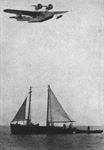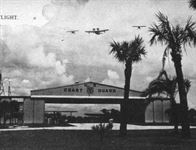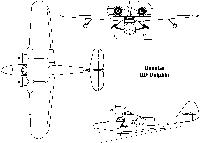Dolphin / RD / OA-4
Амфибия, моноплан смешанной конструкции. Два мотора установлены на пилонах над крылом и соединены небольшой дополнительной плоскостью. Колесное шасси в полете не убирается, а поднимается только при посадке на воду и взлете с нее. Военный вариант гражданской амфибии "Долфин".
Последняя была спроектирована в КБ фирмы "Дуглас эйркрафт" и являлась увеличенной копией опытной машины "Синбэд" (испытывалась в июне 1930 г.). Опытного образца пассажирского "Долфина" не было.
Серийное производство гражданских амфибий началось на заводе "Дуглас" в начале 1931 г. Первый опытный образец самолета для флота, XRD-1, испытывался в августе 1931 г. Серийный выпуск RD развернули с июля 1933 г. Аналогичные машины под обозначением C-21 строились для армии с конца 1931 г. Всего изготовлено 58 "Долфинов", в т.ч. 41 военный.
Самолет состоял на вооружении в США с декабря 1931 г., в Аргентине - с 1934 г., в Австралии - с 1940 г.
Основные серийные модификации:
- Y1C-21 (OA-3), 7-местный штабной, транспортный и спасательный самолет с моторами R-975-3 для армейской авиации;
- Y1C-26 (C-26, OA-4) с моторами R-985-1, удлиненным фюзеляжем, увеличенным крылом и оперением, без дополнительных килевых шайб, для армейской авиации;
- Y1C-26A (OA-4A), аналог Y1C-26 с моторами R-985-5;
- C-26, аналог Y1C-26 с моторами R-985-9;
- RD-2, аналог Y1C-26 для Береговой охраны с моторами R-1340-10 на усиленных фермах;
- RD-3, транспортная амфибия с моторами R-1340-4 или R-1340-96;
- RD-4, спасательный и транспортный самолет с моторами R-1340-96, 8 мест, увеличенный запас топлива.
Все варианты вооружения не имели.
Армейские Y1C-21, Y1C-26, Y1C-26A и C-26B в 1934 г. были переклассифицированы в патрульные амфибии (разведчики)-ОА. В 1936-1937 гг. OA-4, OA-4A, OA-4B модернизировались под один стандарт с установкой цельнометаллического крыла и моторов R-985-9 и были обозначены OA-4C. Базировались в США, Панаме, на Гавайях и Филиппинах до марта 1940 г. Самолеты серии RD использовались флотом и морской пехотой. Береговая охрана после начала войны в Тихом океане применяла RD-4 для патрулирования и спасательных операций в США.
В Австралии в 1940 г. реквизировали 5 гражданских самолетов типов "Долфин" 3, "Долфин" 114, "Долфин" 117 и использовали их как транспортные в тылу и на Новой Гвинее.
Производство самолетов "Долфин" для флота США прекращено в марте 1933 г., для Береговой охраны - в ноябре 1934 г., для армии - в 1935 г. Береговая охрана сняла RD-4 с вооружения в июне 1943 г., в Австралии последние машины служили до мая 1945 г.
RD-4||
Размах:||18,28 м
Длина:||13,96 м
Моторы, количество х мощность:||2х 450 л.с.
Взлетная масса, максимальная:||4350 кг
Максимальная скорость:||250 км/ч
Практический потолок:||5000 м
Дальность:||1210 км
Показать полностьюShow all
Douglas Dolphin и Sinbad (C-21, C-26, C-29 и R2D)
Летающая лодка-амфибия Dolphin представляла собой свободнонесущий моноплан с высокорасположенным крылом. Ее разработали на базе летающей лодки Sinbad с двумя звездообразными моторами Wright Whirlwind J-5C мощностью по 300 л.с. (224 кВт). Лодка Sinbad впервые взлетела в июле 1930 года.
Единственный экземпляр этой лодки служил в Береговой охране США с 1931 по 1939 год. Лодки Dolphin и Sinbad имели одинаковую компоновку силовой установки: два звездообразных мотора, установленных на стойках над крылом, каждый из которых вращал тянущий винт. Введенные на амфибии Dolphin шасси включали основные стойки, прикрепленные к корпусу шарнирными стойками V-образного сечения, а к нижней поверхности крыла - опорами с масляным амортизатором. Лодка Sinbad имела хвостовой костыль, а лодка Dolphin получила хвостовое колесо за вторым реданом. В полете либо при действиях с воды основные стойки шасси убирались выше ватерлинии. Пилоты сидели бок о бок в полностью закрытой кабине перед крылом. За ними начинался пассажирский салон.
У лодки Dolphin над верхними частями мотогондол имелась характерная вспомогательная аэродинамическая поверхность для снятия проблем обтекания. На ранних экземплярах также была пара вспомогательных килей для обеспечения дополнительной продольной устойчивости. Конструкции лодок Dolphin и Sinbad с цельнометаллическим корпусом и деревянным крылом с фанерной обшивкой были схожими, но носовая часть корпуса Dolphin была пересмотрена.
Всего собрали 58 лодок Dolphin. Эта машина завоевала хорошую репутацию за надежность и целый ряд успешных спасательных операций, осуществленных Береговой охраной и ВМФ США. Было не менее 17 версий Dolphin, отличавшихся друг от друга силовыми установками и компоновкой пассажирского салона. Основной модификацией стала 14-я построенная лодка, получившая реконструированные стабилизатор и один большой киль. Также увеличили площадь крыла и удлинили корпус.
Первые две лодки Dolphin построили для авиакомпании "Wilmington-Catalina Airline", осуществлявшей перевозки между Лос-Анджелесом и островом Санта-Каталина на расстояние всего 32 км. Эти лодки с моторами J-5C мощностью 300 л. с. (224 кВт) первоначально назывались Model 1 с кабиной для двух пилотов и шести пассажиров; позднее эти две машины модифицировали в Model 1 Special с увеличенным салоном для восьми пассажиров. Серийный выпуск лодок Dolphin продолжался до 1935 года. Большинство этих машин попало в Армию, ВМФ и Береговую охрану США. Несколько таких лодок пережили Вторую мировую войну.
Варианты
Y1C-21: восемь заказанных в 1931 году для авиакорпуса Армии США лодок, предназначенных первоначально для сопровождения бомбардировщиков в трансокеанских полетах с обеспечением навигации и спасения экипажей в случае необходимости. Высокая скорость поступивших на вооружение бомбардировщиков Martin B-10 и B-12 упразднила эту стратегию, и лодки, к тому времени обозначенные C-21, использовались для перевозок войск в прибрежных районах. Позднее их одолжили казначейству США (с временным кодом FP-1) для патрулирования границ и борьбы с контрабандой. К концу своей карьеры в авиакорпусе Армии США эти самолеты, позднее переименованные в OA-3 (гидросамолет наблюдения), использовались главным образом для грузоперевозок
Y1C-26: две поставленные авиакорпусу Армии США в 1933 году лодки, получившие увеличенный киль и руль направления без вспомогательных килей. Позднее их переименовали в C-26, а затем в OA-4, а также в FP-2 при временном использовании в казначействе США. Позднее эти лодки оснастили крыльями из нержавеющей стали и моторами Pratt & Whitney R-985-9 мощностью 400 л. с. (298 кВт), переименовав в OA-4C
C-26A: восемь лодок, лишь слегка отличавшихся от версии C-26, были поставлены вскоре после Y1C-26 и имели временное обозначение FP-2A казначейства США. В 1936 году четыре лодки модернизировали и переименовали в OA-4C
C-26B: четыре лодки, поставленные авиакорпусу Армии США в 1933 году с моторами R-985-9, позднее переименованы в OA-4B. Одна использовалась для экспериментов с трехстоечным шасси, другую позднее переделали в стандарт OA-4C
C-29: две лодки со звездообразными моторами Pratt & Whitney R-1340-29 мощностью по 550 л. с. (410 кВт), построенные в 1933 году для авиакорпуса Армии США. При аренде казначейством США этот тип назывался FP-2B
XRD-1: лодка, поставленная ВМФ США в августе 1931 года с двумя звездообразными моторами Wright R-975E Whirlwind мощностью 435 л.с. (324 кВт). Использовалась в течение семи лет для перевозки войск
RD: гражданская лодка Model 1 Special, приобретенная для патрулирования Береговой охраной США в августе 1932 года; служила до 1939 года
RD-2: четыре лодки, первая из которых имела такую же конструкцию, как и C-26, и была поставлена Береговой охране США с двумя звездообразными моторами R-1340-10 Wasp Junior мощностью по 500 л.с. (373 кВт), а три дальнейшие больше походили на C-26A. Одна из них с июня 1933 до 1939 года использовалась в качестве персонального самолета президента США Франклина Д. Рузвельта; она оснащалась моторами R-1340-1 мощностью 410 л.с. (307 кВт). Позднее их заменили моторами R-1340-10 по 500 л.с. (373 кВт). Две другие лодки с моторами R-1340-29 по 450 л.с. (336 кВт) имели более скромную отделку и до марта 1940 года использовались для перевозок моряков
RD-3: шесть лодок, поставленных ВМФ США в 1935-1936 годах в виде версий многоцелевого транспортного самолета RD-2
RD-4: 10 лодок, построенных по стандарту RD-3, но с моторами R-985-C1 по 420 л.с. (313 кВт). Все поставлены Береговой охране США и использовались главным образом для спасения на море. Четыре лодки применялись для прибрежного патрулирования, когда Береговую охрану США объединили с ВМФ при вступлении США во Вторую мировую войну. Все эти лодки списали к июню 1943 года
Civil Dolphin: кроме первых двух, были построены еще более 10 гражданских машин. Model 3 была построена для американского миллионера в 1931 году и отличалась четырехместным роскошным салоном. Позднее ее продали австралийскому владельцу, затем приняли в ВВС Австралии и использовали для связных полетов в 1942-1945 годы. Оставшиеся гражданские машины напоминали лодки RD-4 Береговой охраны США; одна с моторами Wasp S1D1 мощностью 550 л. с. (410 кВт) была продана французскому владельцу, а остальные шесть построили по индивидуальным заказам богатых американцев. Одну из них купил Уильям Боинг, основатель фирмы "Boeing". Последние два Dolphin ушли в авиакомпанию "China National Aviation" (филиал "Pan Am"). Они летали между Шанхаем и Кантоном в течение ряда лет
ТАКТИКО-ТЕХНИЧЕСКИЕ ХАРАКТЕРИСТИКИ
Douglas C-21
Тип: транспортно-пассажирская летающая лодка-амфибия с экипажем из двух человек
Силовая установка: два ПД Wright R-975-3 мощностью по 350 л. с. (261 кВт) каждый
Летные характеристики: максимальная скорость 225 км/ч на уровне моря; крейсерская скорость 192 км/ч на оптимальной высоте; набор высоты 3050 м за 18 мин 30 с; практический потолок 4330 м; радиус действия 885 км
Масса: пустого самолета 2659 кг; максимальная взлетная 3893 кг
Размеры: размах крыла 18,29 м; длина 13,36 м; высота 4,29 м; площадь крыла 52,21 м!
Полезная нагрузка: до восьми пассажиров
Показать полностьюShow all
Flight, October 1931
The Douglas "Dolphin" Amphibian
SOMETHING of a sensation was caused in aviation circles in the Dominion of Canada recently when, introduced by the newly-formed firm, Aerial Distributors, Ltd., of University Tower, Montreal, a Douglas "Dolphin" amphibian flying-boat paid a (literally) flying visit to Montreal, Ottawa, and the territory adjacent thereto. On its return to New York it carried as passenger Col. Mulock, C.B.E., D.S.O., of Canadian Airways, Ltd., who has since expressed extreme satisfaction with its performance.
Product of a firm which has hitherto been kept adequately occupied with naval and military orders for the United States Government, the "Dolphin" is a high-wing cantilever commercial monoplane with its twin engines mounted in nacelles high above the wings, and considerably forward of the leading edge. Its outstanding points are its extremely high cruising speed (for an amphibian); its ease of manoeuvrability both in the air and on the water, coupled with exceptionally clean running on the surface; and the manner in which structural weight has been held down without sacrifice of strength to give low (and almost identical) factors of wing and power loading.
Built at Santa Monica, California, by the Douglas Aircraft Company, the present model of the "Dolphin" is the result of a series of experiments that extended over a considerable period before the craft was first presented to the public at the recent Detroit Show. Such alterations as have been made have brought marked improvements. Chief among them are the addition of a small wing mounted above the engine nacelles, joining and acting as a tie to them, and extending a few feet beyond them on either side; and the redesigning of the front portion of the hull, introducing a change from the more or less conventional blunt nose of a flying-boat to a bow modelled on the fore part of a motor launch. Both these changes have more than justified their adoption.
The hull of the "Dolphin" is of anodically-treated duralumin throughout, divided into six watertight compartments, all easily accessible for maintenance and inspection. Access to the bottom and keel is gained by lifting out sections of centre board throughout the entire length of the occupied portion of the structure. The nose consists of an extra strong compartment which makes it safe (though probably expensive) to ram other craft when taxying. Just aft of this is the forward baggage hold of 50 cub. ft., provided with a hatch from which the operations of anchoring or tying up can be carried out expeditiously and clear of the propellers. Next comes the cockpit, with 97 cub. ft. of space, and excellent visibility. All windows are adjustable, and those in front may be opened six inches to allow of direct vision in sticky weather without any draught entering the compartment.
Dual wheel control is standard, with rudder pedals on which the Bendix brake mechanism is actuated by slight pressure of the toe. Elevators and rudder are balanced, and, although the ailerons are not, lateral control is very light. The rudder control is amply sufficient, without using both feet, on the same pedal, to turn against either engine alone, and it is not necessary to go through the acrobatic feats so long associated with flying-boats in order to get one's nose down in the split-second following the cutting out of the engines. Flying hands off, the machine picks up its own gliding angle when the power is shut off, and another interesting feature is that it may be taxied, or really hydroplaned, at 65 or 70 knots "hands off," without any tendency to bounce or jump into the air. An almost imperceptible pull back on the wheel lifts her off without any fuss. As previously indicated, the engines are mounted well forward of the leading edge, with the result that the propeller line is in front of the pilot's cockpit, and consequently of all the human occupants, except when someone is in the forward hatch.
A door separates the control compartment from the cabin, winch is 10 ft. 4 in. long, 4 ft. 4 in. wide and 4 ft. 6 in. high, upholstered in customer's choice of finish, well ventilated and exceptionally quiet, due to its remoteness from the engines. An easily removable window is fitted on either side, providing an aperture amply large enough for an emergency exit for the largest passenger. Additional baggage room and a lavatory occupy the space to the rear of the cabin. Six adjustable chairs with head-rests provide comfortable accommodation for the voyagers.
Just behind the passenger and baggage compartments, the hull departs from conventional boat practice and follows a design that is becoming increasingly common on American craft. The tail wheel is mounted at the heel of the second step, and what remains of the hull is more in the nature of a fuselage, carrying the tail surfaces at its extremity, but sustaining none of the shocks of landing. It is not normally in contact with the water, and it would require an extremely "cabre" landing to bring it into contact with the surface. The entire tail unit is of dural on spars and ribs of the same material.
The wing of the demonstration model which visited Montreal is of wooden construction, plywood surfaced, but succeeding craft are to have all-metal lifting surfaces, so there is little need to describe its construction. Fuel is carried in tanks of 90 (American) gallons capacity inside the wing, and outboard of the hull. Either engine may be fed from either or both pumps, and for emergencies there is a hand-operated wobble pump in the cockpit. Two 300-h.p. engines are, mounted in nicely streamlined nacelles.
The oleo-pneumatic landing gear is ingeniously devised. The two hinged struts attached to the hull are enclosed in a streamlined or aerofoil section fairing, and in the raised position become small stub wings on either side with a pronounced dihedral. Here they can do a minimum of harm, and may, perhaps, help to lift their own weight. The landing gear has a tread of about 12 1/2 ft. and can be raised or lowered by either pilot in 30 sec. The drag of the oleo strut is halved when the wheels are raised, because it is then only half its extended length.
With the power plant mentioned above, the "Dolphin" has a power loading of but 13 lb. per h.p., an all-out speed of 150 m.p.h., a cruising speed of 125, and a landing speed of 60-65. Its climb is about 900 ft. per min. at a gross weight of 7,800 lb. The dimensioned drawings will give an idea of its size and of other characteristics. No amphibian as yet seen in Canada has anything like the performance of this machine, and with the recent reduction in airmail agreements and the consequent access of interest in passenger and freight carrying and other sources of revenue, it seems to have arrived at an opportune moment. The accompanying photograph, taken through the glass of the cockpit with an ordinary (and very aged) Kodak, gives some idea of its possibilities for aerial survey and photography.
Показать полностьюShow all
Flight, February 1934
The Latest Douglas "Dolphin"
THE "Dolphin" is by now well known to readers of FLIGHT. Its excellent service in the U.S. Army, Navy and Coast Guard is also famous. The type was originally produced with two 300-h.p. Wright "Whirlwinds," but recently two Pratt & Whitney "Wasp" S.C.-1's (450 b.h.p. at 6,000 ft.) have been fitted as an alternative to the "Whirlwind," with a large increase in the performance of the machine. A military version of the "Dolphin" has also been produced. On this model, the body upholstery, soundproofing, carpets, lounge chairs and miscellaneous furnishings are omitted and simpler installations better suited to military use are substituted. The saving in weight amounts to approximately 300 lb. The "Dolphins" supplied to the U.S. Army, Navy and Coast Guard are equipped for a variety of duties, including transport, wireless navigational training target towing and ambulance work. When fitted for offensive duty the "Dolphin" may be fitted with a 0.30 calibre machine gun on a special mounting in the bow operated from the hatchway in the forward baggage compartment. A similar installation may be provided at the rear of the entrance hatchway aft of the wing. The normal ammunition provision for each gun is 485 rounds. A bomb load of 584 lb. comprised of bombs of various sizes may be carried in two type A-3 racks mounted under the wings. The A-3 rack is designed to carry five 25-lb. bombs, three 50-lb. bombs, two 100-lb. bombs, or a combination of all three sizes. The normal load for each rack is 240 lb. However, a maximum load of 292 lb. may be carried. "Selective" and "salvo" release levers may be fitted in the pilot's cockpit or in the front or rear gunners' compartment.
Показать полностьюShow all


























